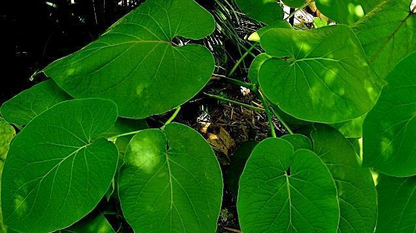
tel: 512 280-1192 thursday, july 30, 2015
Nursery Notes: 3 special buy-one-get-one-free offers for our
gardeners this week: Prides of Barbados, Mexican Bush Sage,
and Sweet Basil: all in 4.5 " rounds for $3.59. Please drop by
for a visit!

9 Ways to Create Curb Appeal with Grasses: writer Michelle
Slattalla encourages us to explore this 'cornerstone of a naturalistic
style of landscape design. . . the graceful, architectural clumps are
equally striking when planted in broad swathes or as punctuation
in an ornamental garden bed.' Gardenista
____________________________________________________
How to Build your own Drip Irrigation System: rather than
wastefully throwing water into the air, drip systems 'are geared for
precision and are highly adaptable, allowing gardeners to fine-tune
how much water each and every plant receives,' writes Brian Barth.

Gorgonzola & Fig Pizza: it's hard to imagine a pizza more dec-
adent than this. Our neighbor Linda has a grove of brown turkey
fig trees, and always shares them with us at this time of year
(writes Darrel Mayers). So Tuesday night was pizza night at our
house. Find the recipe at Epicurious (The pizza crust came from
Central Market: $2.50)
____________________________________________________
Central Texas Gardener: Shawna Coronado grows UP with liv-
ing walls. On tour, a visit to the American Botanical Council’s
eastside gardens for health. Sat., 4 p.m. & Sun. at 9 a.m. KLRU

The Amazing Hoya Santa
by Mick Vann
Hoja santa (Piper auritum) is an aromatic herb with a large, heart-
shaped, velvety leaf which grows in the tropics of Latin America.
The name hoja santa means “sacred leaf” in Spanish, but it goes by
other monikers: acuyo, yerba santa, hierba santa, Mexican pepper-
leaf, root beer plant, and sacred pepper.
A Mexican legend says that the Virgin Mary dried diapers of the
infant Jesus on the branches of this plant, hence the name. Sounds
implausible to me, and diapers do not sanctify a plant in my book,
but stranger things have happened.
It is often used in Mexican cuisine, especially around Veracruz, as
a wrapper for cheeses, tamales, or for seasoned seafood, poultry,
or meats which are then steamed or baked; the leaf itself is not us-
ually eaten when used as a wrapper. It is mainly a flavoring agent
that is discarded after the filling is eaten.
It is an essential ingredient in mole verde and mole amarillo, green
and yellow seasoning pastes from the Oaxaca region. It is also
chopped up or julienned and added to stews and soups, and added
to scrambled eggs; when added to moles, soups, stews, or eggs,
it is eaten.
In central Mexico hoja santa is used to flavor chocolate drinks, and
in Tabasco and Yucatán it is an ingredient in a green liquor called
Verdín. While most often used fresh, hoja santa can also be used in
dried form, although drying subdues much of the flavor and makes
the leaf too brittle to be used as a wrapper.
Hoja santa is a member of the pepper family, so there is a slight
peppery element to the flavor. It contains some of the same aro-
matic oils found in sassafras (safrole in particular), hence the root
beer smell.
The taste is unique, with definite root beer nuances and a sweet
anise edge; immediately apparent when you crush or nibble on a
leaf. It is complimentary to the basic Mexican flavors of cilantro,
lime, garlic, and chile peppers, and when cooked, sort of lurks in
the flavor background rather than dominate.
If you are going to use it to wrap a food, the leaf either has to have
been picked far enough in advance to have sufficiently wilted, or
the veins will crack and the leaf will split when you try to wrap
with it. An alternative is to soak the leaves in hot water to make
them limp enough to fold, although this reduces the flavor inten-
sity slightly.
Hoja santa grows very well in the Austin area, preferring a rich,
moist soil with lots of compost, and morning to midday sun with
afternoon shade. It will freeze to the ground with the first frost, but
re-emerge late in the spring and rapidly grow to 6+ feet in height.
It spreads by underground roots, so it can be a little invasive; give
it plenty of room to grow.
To cook with hoja santa try wrapping fish fillets, shrimp, scallops,
chicken, or pork in a leaf with aromatics like garlic, shallots, or
grated onion, using a little white wine, butter, and citrus.
A Mexican verde sauce made from roasted tomatillos, garlic, and
scallions, cilantro, Serrano chiles, and lime pairs well with the leaf,
as does a Veracruz-style sauce of olive oil, tomato, garlic, white
wine, capers, olives, green chiles, parsley, cilantro, and butter.
It also works reasonably well in a pesto, or minced and tossed with
pasta. Grows like a weed, makes a dramatic accent in the landscape,
and tastes great on the plate; what more could you ask for?
Mick Vann is a food writer, chef, restaurant consultant, and horti-
culturist. More articles at his blog: gustidude
____________________________________________________


Please contact newsletter editor Darrel Mayers (pictured above)
with any ideas for articles or interesting links:
internationalrain@yahoo.com
(hitting 'reply' to this email won't work)
Visit the website: Its About Thyme
Visit the nursery:11726 Manchaca Road, Austin, 78748
Like us on facebook